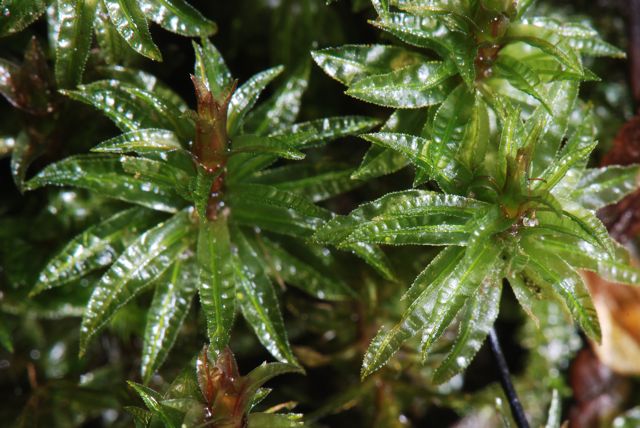Atrichum Palisot de Beauvois, 1804, nomen conservandum.

Atrichum selwynii, photo by Wilson
Atrichum is a very common moss of soil banks and other areas of exposed mineral soil in most of the moist, low to medium elevation areas of California. It is absolutely unmistakable even under the hand-lens. Its leaves are undulate even when moist; the strongly developed limbidium has prominent marginal teeth, mostly geminate; and the low photosynthetic lamellae, in a hand-lens view, appear as markedly darkened streaks over the costa. The species of Atrichum are close and difficult to distinguish. The sexuality of individual species has been one of the more emphasized of characters used in species comparisons. Unfortunately, we have found the dioicous character attributed to A. selwynii to be questionable. On several occasions clones observed in the field as male have, upon visits in later years, been found to have changed with age into females.
Key to Atrichum Etc.
In this key we treat acrocarpous mosses with photosynthetic lamellae but with those lamellae few, leaving much of the leaf lamina not covered. The plants included here are crispate and often undulate.
Species included in this key are all in Polytrichaceae:
Atrichum selwynii Austin
Atrichum tenellum (Röhling) Bruch & W. P. Schimper in Bruch & W. P. Schimper, not known from CA
Atrichum undulatum (Hedwig) Palisot de Beauvois
Bartramiopsis lescurii (T. P. James) Kindberg, not known from CA
Oligotrichum aligerum Mitten, not known from CA
Oligotrichum hercynicum (Hedwig) Lamarck & A. P. de Candolle
Oligotrichum parallelum (Mitten) Kindberg, not known from CA
Among the more useful characters in Atrichum may be leaf shape, height of photosynthetic lamellae, and size and wall thickness of median laminal cells. The height of the photosynthetic lamellae is best determined by inspection of a number of excised leaves with subsequent cross-sectioning of the leaf seen under the dissection scope.
A. Leaves with a well-defined limbidium of elongate cells and with that limbidium possessing geminate teeth .....B
A. Leaves without a limbidium and marginal teeth singly placed .....E
B. Highest photosynthetic lamellae 4-6 or more cells in height; median leaf cells 25-40 µm in longest diameter; cell walls thin with minute corner thickenings; calyptra without hairs .....C
B. Highest photosynthetic lamellae 4 or fewer cells in height; median leaf cells to 25 µm in longest diameter; cell walls thick with corner thickenings; calyptra with a few hairs on its distal portions .....D
C. Leaves comose distally, normally with a few teeth protruding off the lamina along lines of the undulations; leaves rather blunt at apex; capsule cylindric, more than 4:1, widest near its base .....Atrichum selwynii
C. Leaves evenly spaced along the stem, with teeth on lamina absent or few and blunt; leaves acute at apex; capsule oblong, less than 2:1 .....Atrichum tenellum not known from CA
D. Leaves evenly spaced around the stem; laminal cells above the leaf middle isodiametric; capsules arcuate, mostly less than 4 mm long .....Atrichum undulatum
D. Leaves comosely arranged on stem; laminal cells above the leaf middle transversely elongate; capsules nearly straight, mostly longer ..... Atrichum species A
E. Leaf base with uniseriate, multicellular cilia on leaf shoulders; lamina at mid-leaf bistratose .....Bartramiopsis: B. lescurii not known from CA
E. Leaf shoulders without such cilia; lamina unistratose or with bistratose streaks ..... Oligotrichum

